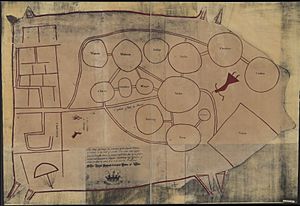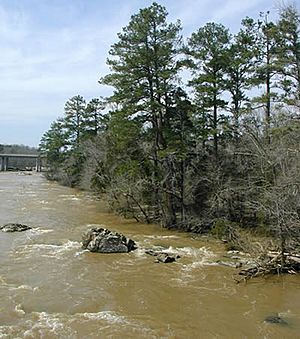Sissipahaw facts for kids
Quick facts for kids
Saxapahaw, North Carolina
|
|
|---|---|

Location of Saxapahaw, North Carolina
|
The Sissipahaw or Haw Tribe was a group of Native American people who lived in North Carolina a long time ago. They spoke a language called Siouan, which was common among many tribes in the area. You might also see their name spelled as Saxahapaw or Sissipahaus.
Their homes were usually near what is now Saxapahaw, North Carolina, along the Haw River in Alamance County. The first time they were written about was in the 1500s by a Spanish explorer named Vendera. The Sissipahaw Tribe was last mentioned in history when they joined the Yamasee people in a conflict against the English settlers in 1715. This event is known as the Yamasee War.
Life and Culture of the Sissipahaw Tribe
Not much is known about the Sissipahaw Tribe, but we have learned a few things from history and old sites.
Archaeologists, who study ancient cultures, have found clues in Alamance County. These clues suggest that the Sissipahaw lived in homes similar to wigwams. They were farmers who grew important crops like corn and beans. They also hunted animals in the forests, such as turkey, deer, and bear, for food.
The Sissipahaw Tribe was very close to the Shakori Tribe. They might have been a smaller part of the Shakori, or perhaps they were a separate tribe that was strongly allied with them.
The Sissipahaw Language
The language spoken by the Sissipahaw Tribe is no longer used today. However, experts believe it was a Siouan language, possibly a dialect (a different version) of the Shakori language.
Only a few words from their language were ever written down. These include:
- unche, which meant 'one'
- necte, which meant 'two'
- wartsan, which meant 'ten'
- unche schanwan, which meant 'eleven'
Legacy of the Sissipahaw
After the Yamasee War in 1715, there are no more records of the Sissipahaw Tribe as a separate group. It is thought that the few survivors of the tribe joined other related Native American groups. Many tribes at that time faced challenges from new diseases and conflicts.
It is believed that the Sissipahaw survivors, along with remnants of other tribes like the Shakori, eventually merged with the Catawba Tribe. Even though the Sissipahaw Tribe no longer exists as a distinct group, their presence is still remembered in local names today. For example, places like Alamance, Saxapahaw, Haw River, and Ossipee, North Carolina carry names that remind us of their history.



